
The official headquarters of the United Nations (UN) is in New York City, New York, United States. It is in the Turtle Bay neighborhood of Midtown Manhattan, on 17 to 18 acres of grounds overlooking the East River. It borders First Avenue to the west, East 42nd Street to the south, East 48th Street to the north, and the East River to the east.

The Minnesota State Capitol is the seat of government for the U.S. state of Minnesota, in its capital city of Saint Paul. It houses the Minnesota Senate, Minnesota House of Representatives, the office of the Attorney General and the office of the Governor. The building also includes a chamber for the Minnesota Supreme Court, although court activities usually take place in the neighboring Minnesota Judicial Center.

Graduate School of Architecture, Planning and Preservation (GSAPP) is the architecture school of Columbia University, a private research university in New York City. It is regarded as an important and prestigious architecture school. It is also home to the Masters of Science program in Advanced Architectural Design, Historic Preservation, Real Estate Development, Urban Design, and Urban Planning.
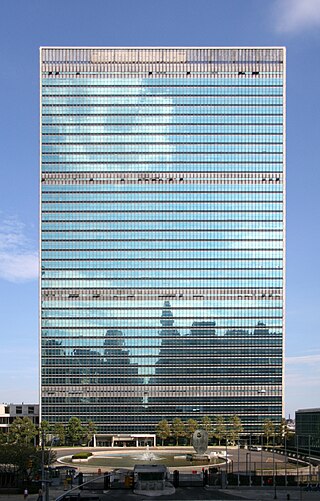
The United Nations Secretariat Building is a skyscraper at the headquarters of the United Nations in the Turtle Bay neighborhood of Manhattan in New York City. It contains the offices of the United Nations Secretariat, the executive organ of the United Nations (UN). The building, designed in the International Style, is 505 ft (154 m) tall with 39 above-ground stories. It was designed by a group of architects led by Wallace Harrison. Although the building is located within the United States, the site is under UN jurisdiction, so the building is exempt from some local regulations.

Arthur Cotton Moore was an American architect who achieved national and international recognition for his contributions to architecture, master planning, furniture design, painting, and writing.

Conservation and restoration of immovable cultural property describes the process through which the material, historical, and design integrity of any immovable cultural property are prolonged through carefully planned interventions. The individual engaged in this pursuit is known as an architectural conservator-restorer. Decisions of when and how to engage in an intervention are critical to the ultimate conservation-restoration of cultural heritage. Ultimately, the decision is value based: a combination of artistic, contextual, and informational values is normally considered. In some cases, a decision to not intervene may be the most appropriate choice.
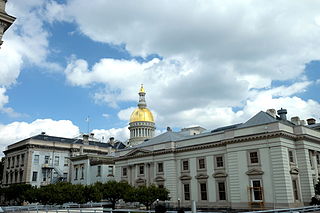
The New Jersey State House is the capitol building of the U.S. state of New Jersey and is the third-oldest state house in continuous legislative use in the United States. Located in Trenton, it was originally built in 1792 and is notable for its close proximity to the state border with Pennsylvania, which makes it the closest capitol building to a state border. The building accommodates both the New Jersey Legislature's Senate and General Assembly chambers, offices of the Governor, Lieutenant Governor, and various state government departments.
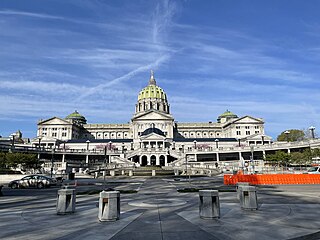
The Pennsylvania State Capitol is the seat of government for the U.S. state of Pennsylvania located in downtown Harrisburg which was designed by architect Joseph Miller Huston in 1902 and completed in 1906 in a Beaux-Arts style with decorative Renaissance themes throughout. The capitol houses the legislative chambers for the Pennsylvania General Assembly, made up of the House of Representatives and the Senate, and the Harrisburg chambers for the Supreme and Superior Courts of Pennsylvania, as well as the offices of the Governor and the Lieutenant Governor. It is also the main building of the Pennsylvania State Capitol Complex.

Thomas Vonier is an architect with a private practice based in Paris and Washington D.C. He is a senior partner in Chesapeake Strategies Ltd, advising organizations on innovations in the building, design, security, and urban sectors.
Giorgio Cavaglieri was an Italian architect and a leading figure in the historic preservationist movement in New York City. He is best known for his 1960s restoration of the Jefferson Market Library in Greenwich Village.
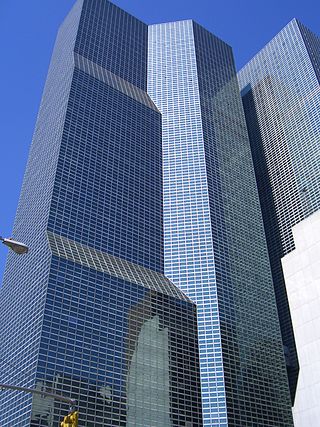
The Millennium Hilton New York One UN Plaza is a 439-room hotel in the East Midtown neighborhood of Manhattan in New York City, United States. Designed by architect Kevin Roche of the firm Roche-Dinkeloo and opened in 1976, the hotel is located at 44th Street and First Avenue, near the headquarters of the United Nations. It occupies part of the ground floor and top 13 stories of One and Two United Nations Plaza, a pair of 39-story skyscrapers also designed by Roche-Dinkeloo. The UN Plaza Hotel is owned by Millennium & Copthorne Hotels and operated by Hilton Hotels & Resorts. Part of the hotel's interior is a New York City designated landmark.

The MIT School of Architecture and Planning is one of the five schools of the Massachusetts Institute of Technology, located in Cambridge, Massachusetts. Founded in 1865 by William Robert Ware, the school offered the first formal architectural curriculum in the United States and the first architecture program in the world operating within the establishment of a university. MIT SAP is considered a global academic leader in the design field and one of the most accomplished schools in the world. MIT's department of architecture has consistently ranked among the top architecture/built environment schools in the world and from 2015 to 2018 was ranked highest in the world in QS World University Rankings. In 2019, it was ranked second to The Bartlett but regained the number one position later on in the 2020 rankings.

Wiss, Janney, Elstner Associates, Inc. (WJE) is an American corporation of architects, engineers, and materials scientists specializing in the investigation, analysis, testing, and design of repairs for historic and contemporary buildings and structures. Founded in 1956, WJE is headquartered in Northbrook, Illinois, and has over 600 professionals in twenty offices across the United States. WJE personnel are specialized in architectural, structural, and civil engineering; materials conservation, chemistry and petrography, and testing and instrumentation.

The New York Landmarks Conservancy is a non-profit organization "dedicated to preserving, revitalizing, and reusing" historic structures in New York state. It provides technical and financial skills to owners of historic properties. Since its founding, the conservancy has provided more than $60 million in grants and loans.

Hoffmann Architects, Inc., d/b/a Hoffmann Architects and Engineers, is a private architecture and engineering firm based in New Haven, Connecticut, United States, with offices in New York City and Alexandria, Virginia. Founded in 1977 by Hungarian-born architect John J. Hoffmann, the firm specializes in the rehabilitation of the building envelope, including facades, roofs, plazas, terraces, and parking structures, as well as historic / landmark building restoration.
Lee Harris Pomeroy was an American architect and the founding principal of the firm Lee Harris Pomeroy Architects. He was a member of the College of Fellows of the American Institute of Architects, and the Royal Institute of British Architects (RIBA). Pomeroy's work included design and planning for corporate, transportation and institutional facilities in the United States and Asia. Working with New York City Transit over many years. he completed the restoration and modernization projects for a number of historic New York City Subway stations.
Hans Baldauf FAIA LEED AP, is an American architect with an interest in the crafting of the public realm and of private spaces. He works on a wide range of projects, from large mixed-use master plans to retail stores and single-family residences. In the public realm, Baldauf has been deeply involved in the intersection of design and the sustainable food movement, particularly with the creation of marketplaces and food halls. Baldauf served on the board of directors for the Center for Urban Education about Sustainable Agriculture (CUESA), the organization that runs the renowned Ferry Plaza Farmers Market, and as Board President from 2013-2015. Baldauf’s private residences explore the traditions of construction that are evident in the Bay Tradition in architecture. He classifies himself as part of the Fourth Bay Tradition. Over the past two decades he has written about, lectured on and restored buildings designed by the early pioneers of California's Beaux-Arts movement.
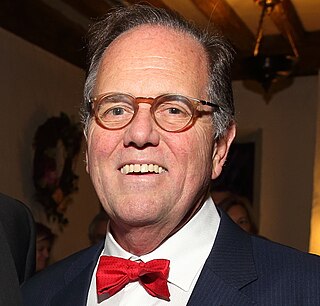
Ethan Anthony is an American architect, author, and academic. As president of Cram and Ferguson Architects LLC, Anthony focuses on the design of the new Traditional American church architecture. During the last three decades, Anthony has designed numerous new traditional churches and interiors and has gained a national reputation for his work in liturgical architecture. His liturgical work can now be found in fifteen states.

The United Nations General Assembly Building is part of the headquarters of the United Nations in the Turtle Bay neighborhood of Manhattan in New York City, United States. It contains the main assembly hall of the United Nations General Assembly, the main deliberative, policymaking, and representative organ of the United Nations (UN). The building was designed by a group of architects led by Wallace Harrison. It is connected to the other buildings in the UN headquarters, including the Secretariat Building and the Dag Hammarskjöld Library. Although the building is physically within the US, it is exempt from some local regulations because the site is under UN jurisdiction.















